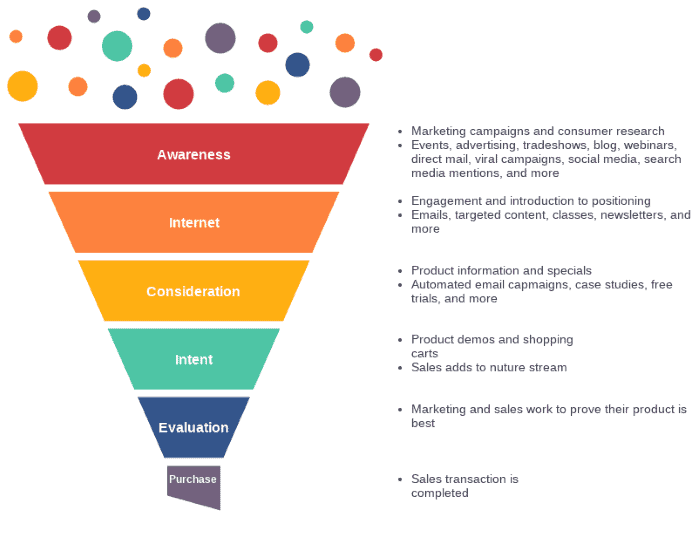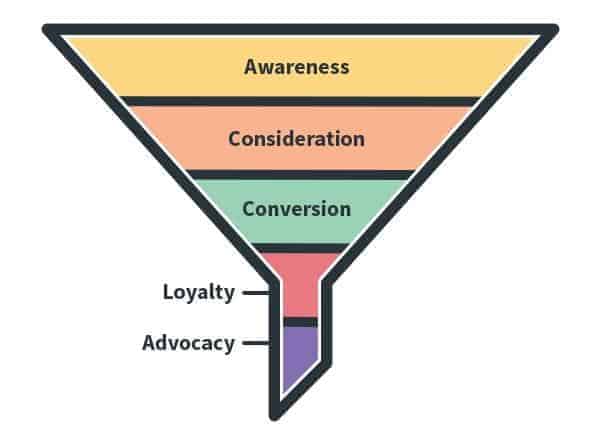Hey there!
Ever wondered how your journey with a loyal customer began?
When they made the first purchase, why did they continue to make purchases and how do they interact with you? To answer all these questions and much more, all you need is a marketing funnel.
What Is A Marketing Funnel?
Simply put, a marketing funnel lays out a customer’s journey with you. From when they first viewed your website, to their first activity and many consecutive ones later on…marketing funnels map out routes to conversions and much more.
Before getting into in detail, let me first show you what a marketing funnel looks like.

Now you notice why it’s called a funnel? Not all the people who see your brand will become customers in the end.
It’s a long process from discovery to purchase and we are going to get into each one of those stages in between.
- Awareness – this is the first stage. The consumer gets to know or ‘becomes aware’ of the existence of your brand or your brand’s product. This is done through events, advertisements, blogs, webinars, direct mails etc.
- Internet engagement – this is slightly related to the second stage. After being made aware, the consumer will now engage over the internet. It can be through emails, forms, newsletters, campaigns etc.
- Consideration – this is perhaps the most important part. After being made aware of your product, the consumer has decided to consider buying it. This is a huge step because there are hundreds of thousands of other choices for thm but something about your product and marketing made them come to you. At this stage, if they are given the right push then they will definitely convert into a consumer. They’ll ask about your product, find out more about it, gauge its pros and cons, maybe look for a sample or a free trial.
- Intent – this means that they have an intention of buying it but have not actually bough it. You know how we bring all products to our cart but don’t get around to checking them out? That’s because we want to buy them but we’re not sure if they are worth the investment.
- Evaluation – here they will look at the reviews and finalise on going ahead with the payment. One last hesitation before buying. Think of it like going to the counter and contemplating taking out your wallet.
- Purchase – congratulations! The potential has finally turned into a consumer! You’ve achieved a lead conversion!
Now that you have an idea about how detailed a marketing funnel can get, you should know that there is another model of the marketing funnel which looks at the bigger picture.

Look how Internet, Intent, and Evaluation have been removed (because they are indecisive moments that were covered in the first model), and two new categories have been added.
- Awareness.
- Consideration.
- Conversion.
- LOYALTY – loyalty can never be bought. Or can it? Discounts, offers, email and social media interactions with people who have bought your product can make them come back to you again. Everyone has loyal customers who, if happy with the first purchase, choose to come back again and again to buy different or same products.
- ADVOCACY – the same loyal customers will then help the brand with future marketing funnels. The best example of this is Wikipedia. The large website recently was in a deficit and was about to be owned by government bodies. They asked their consumers to pay a small amount to help them keep Wikipedia free…and you know what? It worked. Loyal and long time consumers paid so that Wikipedia could be kept afloat and out of the government’s hands.
But why do marketing funnels at all? What is the advantage?
Again, not all the people who see your website are going to become consumers.
This is because as much as you try, there are going to be a lot of factors that might stop a potential from making the conversion.
A marketing funnel is called a funnel because it tapers at the end – and it tapers because you lose potentials on the way.
My point is, the marketing funnel tells you where exactly you are losing customers.
Is at after the awareness stage have you not made it interesting enough for a first-time viewer?
Is it during the considerations stage – maybe one of the features wasn’t good enough or one of the reviews was bad but influential?
Or
is it during the payment stage and they suddenly felt they were in a deficit and decided that it wasn’t worth the money?
AT WHAT POINT IN THE FUNNEL ARE YOU LOSING THEM?
That is what it helps you figure out. And if you know your weaknesses, then you can work on them,
optimize the process and get better results next time.
Another advantage is it deconstructs and simplifies a very long and complicated journey that each consumer has with the brand.
It helps you visualize everything better.
How to build an effective marketing funnel?
I’ll give you something to visualize. Imagine you own a long corridor full of multiple doors. You bring guests at the start and they must walk straight to see the light at the end of the tunnel – a purchase.
But the thing is, even if you have doors in a straight line, you’ve got windows in the side. The windows are all the reasons the potential may find to get out of going into the next door (why they shouldn’t buy the product). So how do you make the consumers walk in a straight line?
You try to close the drapes on as many windows as possible – that is, remove as many escape routes for the consumer.
Figure out all of the possible ways the potential can decide against buying your product and find solutions for them.
Of course, there will still be factors that may get them out of buying your product,
but you need to make sure you minimize such loopholes from your end.
To build an effective marketing funnel, first find out what needs your audience has.
Then make sure your product is going to fill their needs.
This is the most basic thing you should do – you must be able to tell your audience confidence that your product is what they require.
After creating the need, you must create interest.
Very few people will blindly believe words without looking at the facts, especially these days.
So give out information, features, testimonials, scientific studies, and reviews that convince your potential to trust and consider you.
Finally comes the stage to pay. Here you need to understand that not everyone likes spending their money.
Haha, yes, it’s true.
Even when spending money, they want benefits like cashback, discounts, and EMI options on bigger amounts.
So try and pacify your consumer and tell them that you consider them and their financial status and are therefore willing to reduce the price or give free gifts to them.
The more you make it about them, the better it is for you.

